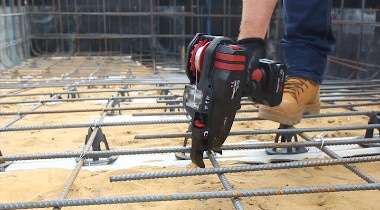
Rebar tying might look easy for an outsider, but it involves repetitive arm and hand twisting movements with high grasp force to get it done. Manually doing it for extended periods could result in repetitive strain injuries and hand-wrist disorders. It also requires workers to be in back-breaking positions that can injure their backs. A rebar tie tool can prevent those problems that can cause project delays, high worker turnover, and healthcare costs.
Bar tying tools are mechanical devices that reduce the risk of wrist, hand, and back injuries. Some models have an optional extension arm to allow workers to stand properly without bending or overreaching to minimise the strain on their muscles and joints.
How does it work?
Place the mouth of the bar tie tool over the conduit joint or rebar, press the trigger, and it will automatically tie, twist and cut the wire for you. The best bar tiers are lithium-ion battery-powered tools that quickly fasten steel bars with tie wire, making them practical for performing simple wrap-and-twist ties. Top-of-the-line rebar tying machines can finish a single tie in less than a second and perform more than 5,000 ties per battery charge.
Uses
Bar tie tools are dependable additions to any construction site where steel reinforcement bars are involved. They save contractors time and money while eliminating manual effort and doing the job efficiently with reduced health and safety issues.
Injury prevention and safety are among the primary reasons to use a bar tie tool. Studies conducted by the Construction Safety Association of Ontario and NIOSH (National Institute for Occupational Safety and Health) compared manual rebar-tying methods and an automated tying tool. They found that the tying tool may minimise the risk of injury to the hands, lower back, and wrists.
In some applications, the rebar tie tool can significantly increase productivity. NIOSH-Ontario studies found that it can efficiently tie rebar twice as fast as manual tying. That said, the actual productivity depends on tying frequency and the type of work. Rod workers and contractors using bar tie tools reported preferring them over manual tying methods.

